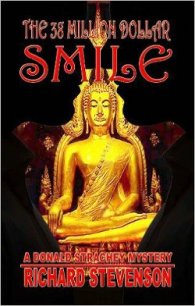Congo - Crichton Michael (книги регистрация онлайн бесплатно .TXT) 📗
Ross fired at the rear door, and blood spattered on her clothes as the intruding Kigani were knocked out backward.
Amy no like, she signed. Amy want go home. She clutched her seat belt.
“There’s the son of a bitch,” Munro shouted, and fired his machine gun. A young man of about twenty, his eyes smeared with red, fell onto his back, shuddering with machine-gun fire. “Got him,” Munro said. “Got the Angawa” He sat back and allowed the warriors to remove the body.”
It was then the Kigani attack ended, the warriors retreating into the silent bush. Munro bent over the slumped body of the pilot and stared out at the jungle.
“What happens now?” Elliot asked. “Have we won?”
Munro shook his head. “They’ll wait for nightfall. Then they’ll come back to kill us all.”
Elliot said, “What will we do then?”
Munro had been thinking about that. He saw no possibility of their leaving the aircraft for at least twenty-four hours.
They needed to defend themselves at night and they needed a wider clearing around the plane during the day. The obvious solution was to burn the waist-high bush in the immediate vicinity of the plane-if they could do that without exploding the residual fuel in the airplane tanks.
“Look for flamethrowers,” he told Kahega, “or gas canisters.” And he began to check for documents that would tell him tank locations on the C-130.
Ross approached him. “We’re in trouble, aren’t we.”
“Yes,” Munro said. He didn’t mention the volcano.
“I suppose I made a mistake.”
“Well, you can atone,” Munro said, “by thinking of some way out.”
“I’ll see what! can do,” she said seriously, and went aft. Fifteen minutes later, she screamed.
Munro spun back into the passenger compartment, his machine gun raised to fire. But he saw that Ross had collapsed into a seat, laughing hysterically. The others stared at her, not sure what to do. He grabbed her shoulders and shook her: “Get a grip on yourself,” he said, but she just went on laughing.
Kбhega stood next to a gas cylinder marked PROPANE. “She see this, and she ask how many more, I tell her six more, she begins to laugh.”
Munro frowned. The cylinder was large, 20 cubic feet. “Kahega, what’d they carry that propane for?”
Kahega shrugged. “Too big for cooking. They need only five, ten cubic feet for cooking.”
Munro said, “And there are six more like this?”
“Yes, boss. Six.”
“That’s a hell of a lot of gas,” Munro said, and then he realized that Ross with her instinct for planning would have grasped at once the significance of all that propane, and Munro also knew what it meant, and he broke into a grin.
Annoyed, Elliot said, “Will someone please tell us what this means?”
“It means,” Munro said through his laughter, “it means things are looking up.”
Buoyed by 50,000 pounds of heated air from the propane gas ring, the gleaming plastic sphere of the consortium balloon lifted off from the jungle floor, and climbed swiftly into the darkening night air.
The Kigani came running from the forest, the warriors brandishing spears and arrows. Pale white arrows sliced up in the fading light, but they fell short, arcing back down to the ground again. The balloon rose steadily into the sky.
At an altitude of 2,000 feet, the sphere caught an easterly wind which carried it away from the dark expanse of the Congo forest, over the smoking red volcanic heart of Mount Mukenko, and across the sharp depression of the Rift Valley, vertical walls shimmering in the moonlight.
From there, the balloon slid across the Zaire border, moving southeast toward Kenya-and civilization.
Epilogue: The Place of Fire
ON SEPTEMBER 18, 1979, THE LANDSAT 3 Satellite, at a nominal altitude of 918 kilometers, recorded a 185-kilometer-wide scan on Band 6 (.7-.8 millimicrons in the infrared spectrum) over central Africa. Penetrating cloud cover over the rain forest, the acquired image clearly showed the eruption of Mount Mukenko still continuing after three months. A computer projection of ejecta estimated 6-8 cubic kilometers of debris dispersed into the atmosphere, and another 2-3 cubic kilometers of lava released down the western flanks of the mountain. The natives called it Kanya4feka, “the place of fire.”
On October 1, 1979, R. B. Travis formally canceled the Blue Contract, reporting that no natural source of Type IIb diamonds could be anticipated in the foreseeable future. The Japanese electronics firm of Monkawa revived interest in the Nagaura artificial boron-doping process. American firms had also begun work on doping; it was expected that the process would be perfected by 1984.
On October 23, Karen Ross resigned from ERTS to work for the U.S. Geological Survey EDC in Sioux Falls, South Dakota, where no military work was conducted, and no fieldwork was possible. She has since married John Bellingham, a scientist at EDC.
Peter Elliot took an indefinite leave of absence from the Berkeley Department of Zoology on October 30. A press release cited “Amy’s increasing maturity and size… making further laboratory research difficult…“ Project Amy was formally disbanded, although most of the staff accompanied Elliot and Amy to the Institut d’Etudes Ethnologiques at Bukama, Zaire. Here Amy’s interaction with wild gorillas continued to be studied in the fold. In November, 1979, she was thought to be pregnant; by then she was spending most of her time with a local gorilla troop, so it was difficult to be sure. She disappeared in May l980.*
The institute conducted a census of mountain gorillas from March to August 1980. The estimate was five thousand animals in all, approximately half the estimate of George Schaller, field biologist, twenty years before. These data confirm that the mountain gorilla is disappearing rapidly.
Zoo reproduction rates have increased, and gorillas are unlikely to become technically extinct, but their habitats are shrinking under the press of mankind, and researchers suspect that the gorilla will vanish as a wild, free-roaming animal in the next few years.
Kabega returned to Nairobi in 1979, working in a Chinese restaurant which went bankrupt in 1980. He then joined the National Geographic Society expedition to Botswana to study hippos.
Aid Ubara, the eldest son of the porter Marawani and a radio astronomer at Cambridge, England, won the Herskovita Prize in 1980 for research on X-ray emissions from the galactic source M322.
At a handsome profit, Charles Munro sold 31 karats of blue Type IIb diamonds on the Amsterdam bourse in late 1979; the diamonds were purchased by Intel, Inc., an American micronics company. Subsequently he was stabbed by a Russian agent in Antwerp in January 1980; the agent’s body was later recovered in Brussels. Munro was arrested by an armed border patrol in Zambia in March 1980, but charges were dropped. He was reported in Somalia in May, but there is no confirmation. He still resides in Tangier.
A Landsat 3 image acquired on January 8, 1980, showed
*In May 1980, Amy disappeared for four months, but in September she returned with a male infant clinging to her chest. Elliot signed to her, and had the unexpected satisfaction of seeing the infant sign back to him Amy like Peter like Peter. The signing was crisp and correct and has been recorded on videotape. Amy would not approach closely with her infant; when the infant moved toward Elliot, Amy grabbed him to her chest, disappearing into the bush. She was later sighted among a troop of twelve gorillas on the slopes of Mt. Kyambara in northeastern Zaire.
that the eruption of Mount Mukenko had ceased. The faint signature of crossed laser beams, recorded on some earlier satellite passes, was no longer visible. The projected intersection point now marked a field of black quatermain lava with an average depth of eight hundred meters-nearly half a mile-over the Lost City of Zinj.


![[Magazine 1968-012] - The Million Monsters Affair - Davis Robert Hart (серия книг .txt) 📗](/uploads/posts/books/56864/56864.jpg)

